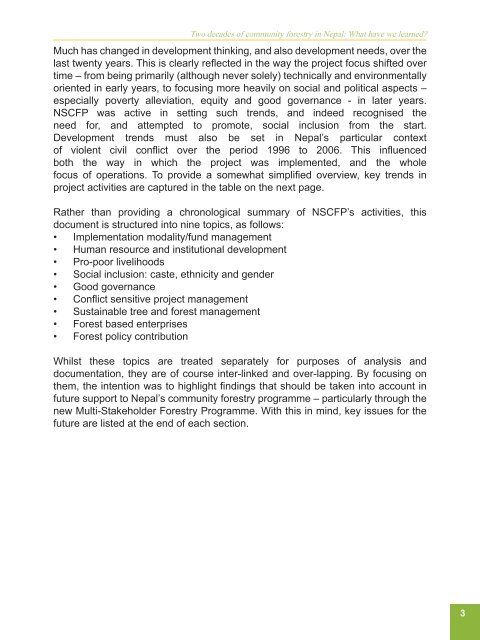Two decades of community forestry in Nepal: What have we learned?
Two decades of community forestry in Nepal: What have we learned?
Two decades of community forestry in Nepal: What have we learned?
You also want an ePaper? Increase the reach of your titles
YUMPU automatically turns print PDFs into web optimized ePapers that Google loves.
<strong>Two</strong> <strong>decades</strong> <strong>of</strong> <strong>community</strong> <strong>forestry</strong> <strong>in</strong> <strong>Nepal</strong>: <strong>What</strong> <strong>have</strong> <strong>we</strong> <strong>learned</strong>?<br />
Much has changed <strong>in</strong> development th<strong>in</strong>k<strong>in</strong>g, and also development needs, over the<br />
last t<strong>we</strong>nty years. This is clearly refl ected <strong>in</strong> the way the project focus shifted over<br />
time – from be<strong>in</strong>g primarily (although never solely) technically and environmentally<br />
oriented <strong>in</strong> early years, to focus<strong>in</strong>g more heavily on social and political aspects –<br />
especially poverty alleviation, equity and good governance - <strong>in</strong> later years.<br />
NSCFP was active <strong>in</strong> sett<strong>in</strong>g such trends, and <strong>in</strong>deed recognised the<br />
need for, and attempted to promote, social <strong>in</strong>clusion from the start.<br />
Development trends must also be set <strong>in</strong> <strong>Nepal</strong>’s particular context<br />
<strong>of</strong> violent civil confl ict over the period 1996 to 2006. This <strong>in</strong>fl uenced<br />
both the way <strong>in</strong> which the project was implemented, and the whole<br />
focus <strong>of</strong> operations. To provide a somewhat simplifi ed overview, key trends <strong>in</strong><br />
project activities are captured <strong>in</strong> the table on the next page.<br />
Rather than provid<strong>in</strong>g a chronological summary <strong>of</strong> NSCFP’s activities, this<br />
document is structured <strong>in</strong>to n<strong>in</strong>e topics, as follows:<br />
• Implementation modality/fund management<br />
• Human resource and <strong>in</strong>stitutional development<br />
• Pro-poor livelihoods<br />
• Social <strong>in</strong>clusion: caste, ethnicity and gender<br />
• Good governance<br />
• Confl ict sensitive project management<br />
• Susta<strong>in</strong>able tree and forest management<br />
• Forest based enterprises<br />
• Forest policy contribution<br />
Whilst these topics are treated separately for purposes <strong>of</strong> analysis and<br />
documentation, they are <strong>of</strong> course <strong>in</strong>ter-l<strong>in</strong>ked and over-lapp<strong>in</strong>g. By focus<strong>in</strong>g on<br />
them, the <strong>in</strong>tention was to highlight fi nd<strong>in</strong>gs that should be taken <strong>in</strong>to account <strong>in</strong><br />
future support to <strong>Nepal</strong>’s <strong>community</strong> <strong>forestry</strong> programme – particularly through the<br />
new Multi-Stakeholder Forestry Programme. With this <strong>in</strong> m<strong>in</strong>d, key issues for the<br />
future are listed at the end <strong>of</strong> each section.<br />
3

















